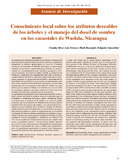Mostrar el registro sencillo del ítem
Conocimiento local sobre los atributos deseables de los árboles y el manejo del dosel de sombra en los cacaotales de Waslala, Nicaragua
| dc.contributor.author | Silva, Claudia | es_ES |
| dc.contributor.author | Orozco Aguilar, Luis | es_ES |
| dc.contributor.author | Rayment, Mark | es_ES |
| dc.contributor.author | Somarriba, Eduardo | es_ES |
| dc.date.accessioned | 2015-03-19T21:09:38Z | |
| dc.date.available | 2015-03-19T21:09:38Z | |
| dc.date.issued | 2013 | |
| dc.identifier | 487797 | es_ES |
| dc.identifier.issn | 1022-7482 | es_ES |
| dc.identifier.uri | https://repositorio.catie.ac.cr/handle/11554/5944 | |
| dc.description.abstract | Se estudiaron los atributos deseables de los árboles y el manejo del dosel de sombra según la edad, ciclo anual y diferentes condiciones fisiográficas en sistemas agroforestales de cacao de 30 familias cacaoteras del municipio de Waslala, Nicaragua. La metodología consistió en entrevistas semiestructuradas, reuniones de grupo y sesiones de retroalimentación para identificar productos y servicios provenientes del dosel de sombra; además, se analizaron las fortalezas y debilidades del conocimiento local sobre el manejo y comportamiento del dosel en diferentes ciclos temporales y condiciones espaciales. La protección del sol (100%), mejoramiento de la fertilidad del suelo (90%) y la generación de subproductos como fruta, leña y madera (100%) fueron los beneficios y servicios más mencionados por los productores. Un árbol de sombra con copa abierta, que no pierda el follaje en la estación seca, con un ritmo de crecimiento rápido y una altura media (15-25 m), fueron los atributos deseables más valorados por los productores. Los productores reconocieron una relación positiva entre la diversidad arbórea del dosel de sombra, mejores condiciones para el crecimiento y producción del cacao y mayor variedad de bienes y servicios para el consumo de la familia y la venta. El estudio demuestra que los productores de Waslala tienen un conocimiento detallado sobre las especies de sombra y sus características fenológicas, pero poco dominio sobre el diseño y manejo del dosel de sombra según la edad de la plantación y ciclo anual. Por otra parte, diferencias percibidas en cuanto al comportamiento de la sombra y el manejo del dosel en distintas condiciones de pendiente y exposición resultaron poco claras para los productores debido a la gran cantidad de factores (geográficos y climáticos) que influyen. Un 73% de los productores mostró preferencia por una sombra más densa en pendientes fuertes y terrenos menos fértiles, mientras que un 23% no hizo diferencias ante tal situación. El conocimiento local sobre la agronomía del cacao se califica como satisfactorio, pero el conocimiento agroforestal en general tiene limitaciones que podrían mejorarse con capacitaciones y asistencia técnica. | es_ES |
| dc.description.abstract | A study was carried out to assess farmers’ knowledge of the positive and negative attributes of shade trees in cocoa agrofor -estry systems in the Waslala Province of Nicaragua. Particular consideration was given to the trees’ spatial and temporal place - ment and the management of the shade canopy. As part of the methodology, semi-structured interviews and ranking exercises were conducted with 30 cocoa farmers of the region; focus group meetings with members of the Cacaonica cooperative were used, and three feedback sessions with farmers and extension workers of the community were conducted at the end of the project. A number of shade canopy products and services were recognized by farmers as beneficial for them; most importantly sunlight protection (mentioned by 100% of the interviewees), soil fertility improvement (90%) and firewood, fruits and timber products (100%). Evergreen, open canopies, high growth rate, and medium height (15-25m) were considered to be the most desirable attributes of the shelter trees by the farmers. Farmers showed a clear understanding of the relationship between having a diversity of shade trees and the provision of products and services, including amelioration of site conditions for cocoa growth and an increased diversity of products for domestic consumption and local retail. On the other hand, understanding of shade canopy management according to temporal cicles and geographical conditions, such as slope and aspect, proved to be more limited, and less unanimous, due to the complexity of the interactions between geographical and climatic factors. Indigenous local knowledge, combined with technical training received over the last two decades through a variety of projects and institutions, has resulted in a uniformly degree of knowledge among the farmers about desirable species patterns and phenological attributes of shade trees, but knowledge about shade canopy management through time and according to its spatial distribution is weak and needs to be consider for future trainings. | en_EN |
| dc.format.mimetype | ||
| dc.language.iso | es | es_ES |
| dc.publisher | CATIE, Turrialba (Costa Rica) | es_ES |
| dc.relation.ispartof | Agroforestería en las Américas, número 49 (2013) | |
| dc.relation.ispartof | Programa Agroambiental Mesoamericano (MAP). Fase I | esp |
| dc.rights.uri | https://creativecommons.org/licenses/by-nc-nd/4.0/ | |
| dc.subject | THEOBROMA CACAO | es_ES |
| dc.subject | CONOCIMIENTO INDIGENA | es_ES |
| dc.subject | ARBOLES | es_ES |
| dc.subject | CARACTERISTICAS AGRONOMICAS | es_ES |
| dc.subject | DOSEL DE SOMBRA | es_ES |
| dc.subject | SOMBRA | es_ES |
| dc.subject | AGROFORESTERIA | es_ES |
| dc.subject | CARACTERISTICAS DEL SITIO | es_ES |
| dc.subject | TECNOLOGIA | es_ES |
| dc.subject | WASLALA | es_ES |
| dc.subject | NICARAGUA | es_ES |
| dc.title | Conocimiento local sobre los atributos deseables de los árboles y el manejo del dosel de sombra en los cacaotales de Waslala, Nicaragua | es_ES |
| dc.type | Artículo | es_ES |
| dc.journal.issueNumber | 49 | |
| dc.journal.pages | 51-60 |



